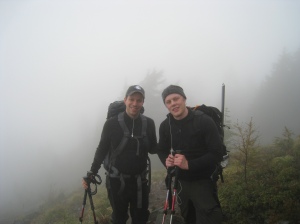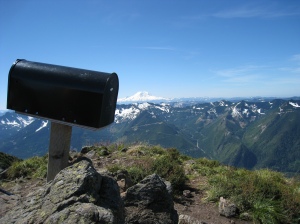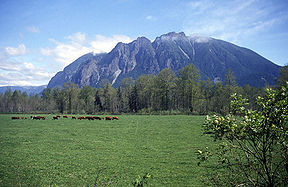On Saturday, June 12th, a group of us headed up to Mt. Rainier to do a training climb to Camp Muir. We lucked out with the weather, as it was the first sunny day in what felt like weeks, and it had to be one of the most beautiful days of the year thus far. I had never been to Camp Muir before, and was excited and nervous for my first alpine experience.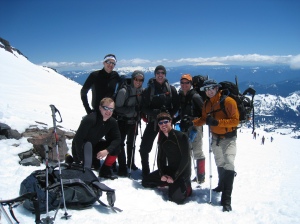
We had six in our group. Our group consisted of myself, Hans, Dan, and Kevin (all participating in the Slalom Rainier climb in two weeks) and we were led by Michael and Margaret, friends of Hans who had been to Muir several times before. It was great to have some experience with us. I packed my backpack will all the gear I had, trying to simulate the experience to come. It weighed about 20 lbs. I will probably be 10 lbs heavier next time. A couple key pieces of gear I had on from the start were my gaiters, mountaineering boots, soft shell pants, and glacier goggles. All were key. I had on sunscreen too, but not enough!
There had been some ominous signs leading up to Saturday, with an avalanche the weekend prior and another high avalanche warning in place in the Cascades. Even our barista chimed in with her two cents as we stopped for coffee on our way down. We checked in with the ranger before heading out and were pleased to hear that the trail to Muir was safe, provided you stayed near it. And when we got there, there was a ton of people headed to Muir, so that was also reassuring.
We arrived at Paradise around 9:30 AM and started the hike at about 10:00 AM. Paradise is at about 5,000 feet and Camp Muir lies just about 10,000 feet. All in all it is about a 5 mile hike that rises 5,000 feet in elevation. And every step in snow. Paradise still had a huge base at this point in the year.
We encountered the first real test at about 6500 feet, which was a trek up a steeper section to Panorama Point. Stepping in previous tracks, it’s almost like going up an ice staircase. After that the slog began and at about the 2 hour mark, we took a break. We were at about 8,00 feet and the views were just spectacular. I was feeling good at this point, but was definitely ready to take off the pack and have a snack and water. It was also fun to snap some pictures and video. The six of us were hiking as a group at this point.
After this rest, we pushed forward. We started to separate a bit at this point, with everyone starting to go at their own comfortable pace. I followed Hans and Kevin, who were in sight but took the lead. It took about two more hours to get to Muir. You can start to see Muir when getting to the beginning of the Muir Snowfield, but you are about 3/4 of a mile out at that point, and it takes a while to finish of the rest of the way. It is slow going towards the top, as the air is thin. I was taking 40 steps at a time and then catching my breath.
Hans arrived first and found several members of our Slalom group that had already ascended. It was a bit of a reunion at the top, and we all were in great spirits having reached 10,000 feet and the Camp. When they called out to me as I arrived, I tried to kick in gear to reach them, but really couldn’t. I had to keep it slow and steady but got there the same. Amazing how a few quick steps will tire you out up here. It took us about 4 hours from Paradise to reach Camp Muir.
We took photos and video as we ate, rested, and chatted over the next hour. I felt really strong after catching my breath, and did not have altitude sickness, which was great. We ran into a group of people who were planning to stay the night, and they had lugged a keg of Rainier beer up to the camp! Needless to say, everyone was in a bit of disbelief at this feat. Apparently 6 people hauling a keg on a sled did the trick. Some of us dumped out a water bottle and filled er up. It was pretty hilarious.
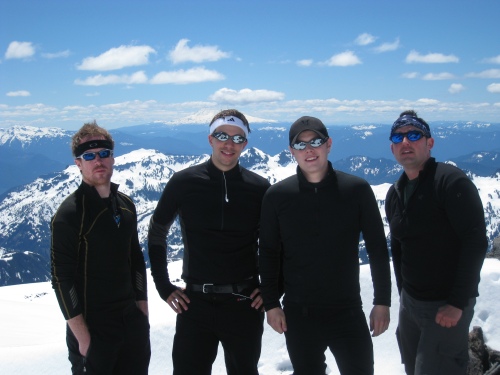 The way down from Muir turned into a real slog. We were able to glissade down some chutes, which was fantastic, but there weren’t near enough of them. The snow turned soft and deep in the afternoon sun, and frequently you ended up sinking in to your knee with each step. We went down at a fast pace, but it felt like a long way down nonetheless. It took about 2 hours to get down. I have a feeling the trek down in a couple of weeks will be long and tough as well.
The way down from Muir turned into a real slog. We were able to glissade down some chutes, which was fantastic, but there weren’t near enough of them. The snow turned soft and deep in the afternoon sun, and frequently you ended up sinking in to your knee with each step. We went down at a fast pace, but it felt like a long way down nonetheless. It took about 2 hours to get down. I have a feeling the trek down in a couple of weeks will be long and tough as well.
All in all it was an amazing day. The views were fantastic and I left feeling much more confident about our trip in two weeks. Making it to 10,000 feet and back, and still feeling pretty good was a great sign.
Here is a link to the YouTube playlist containing other videos from the trip: http://www.youtube.com/view_play_list?p=F4BF29ABC1188383
